Fish Magnets -
The wrecks of South-east Queensland
Published
in Australasian Scuba Diver Magazine - Issue 6: 2005
By Dave Harasti (www.daveharasti.com)
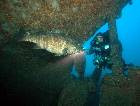 The
waters of south-east Queensland are the final resting place for many ships and
this part of the Australian coastline is a haven for divers interested in ship
wrecks. A diver can fly into Brisbane and within two hours they can be blowing
bubbles on the wreck of the Saint Paul or searching through the many ships and
structures of Curtain Artificial Reef. Some divers get a real thrill out of
diving on shipwrecks as it's something different to swimming around the standard
'fishbowl' coral reef or sponge gardens. Many of my diving colleagues love their
wrecks, actually I would have to say for some of them it's an obsession. Some
of them are more attracted to rust than their own partners, now go figure that
one out! Others get this glint in their eyes which can be instantly recognised
as 'Brass Fever'; I thinks that's pretty self explanatory!
The
waters of south-east Queensland are the final resting place for many ships and
this part of the Australian coastline is a haven for divers interested in ship
wrecks. A diver can fly into Brisbane and within two hours they can be blowing
bubbles on the wreck of the Saint Paul or searching through the many ships and
structures of Curtain Artificial Reef. Some divers get a real thrill out of
diving on shipwrecks as it's something different to swimming around the standard
'fishbowl' coral reef or sponge gardens. Many of my diving colleagues love their
wrecks, actually I would have to say for some of them it's an obsession. Some
of them are more attracted to rust than their own partners, now go figure that
one out! Others get this glint in their eyes which can be instantly recognised
as 'Brass Fever'; I thinks that's pretty self explanatory!
 I
do enjoy diving on shipwrecks however I seem to be lacking the 'rust' gene that
attracts most people to these dive sites. My attraction to wrecks is what can
be found living on them. Most photographer's will put on a wide angle lens on
their camera for a wreck dive; I on the other hand prefer to shoot macro photography
and am more interested in shooting fish and nudibranchs than a hunk of rust.
Wrecks truly act as fish magnets and without a doubt are the most productive
form of an 'artificial' reef.
I
do enjoy diving on shipwrecks however I seem to be lacking the 'rust' gene that
attracts most people to these dive sites. My attraction to wrecks is what can
be found living on them. Most photographer's will put on a wide angle lens on
their camera for a wreck dive; I on the other hand prefer to shoot macro photography
and am more interested in shooting fish and nudibranchs than a hunk of rust.
Wrecks truly act as fish magnets and without a doubt are the most productive
form of an 'artificial' reef.
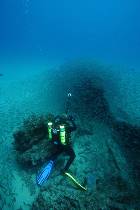 Why
is that fish are so attracted to wrecks? Well here's an interesting way of looking
at that very question. Imagine you are walking through the desert and for miles
and miles all you see is sand until you spot a palm tree in the distance. What
would you do? Well you obviously go to the palm tree as it's the only structure
around. This same principle applies in the ocean to fish. A small fish travelling
across barren sand comes across a wreck and realises that this makes a nice
new home. Small fish take up residence, which in turn attracts larger fish that
prey on the smaller species, and then eventually larger predators such as gropers
and sharks claim the wreck as their new territory. This same principle can be
applied to the Fish Aggregating Devices (FADs) that are deployed on the open
ocean for commercial and recreational fishing.
Why
is that fish are so attracted to wrecks? Well here's an interesting way of looking
at that very question. Imagine you are walking through the desert and for miles
and miles all you see is sand until you spot a palm tree in the distance. What
would you do? Well you obviously go to the palm tree as it's the only structure
around. This same principle applies in the ocean to fish. A small fish travelling
across barren sand comes across a wreck and realises that this makes a nice
new home. Small fish take up residence, which in turn attracts larger fish that
prey on the smaller species, and then eventually larger predators such as gropers
and sharks claim the wreck as their new territory. This same principle can be
applied to the Fish Aggregating Devices (FADs) that are deployed on the open
ocean for commercial and recreational fishing.
Over the past 12
months I have conducted four trips on the MV Esperance Star utilising the expertise
of skipper Trevor Jackson to photograph and document the diversity and abundance
of marine life on some of the wrecks of south-east Queensland. Some of the more
productive wrecks for fish life include:
The Aarhus:
The Aarhus is one of Queensland's most historic shipwrecks and was a sailing
barque that struck Smith Rock off Moreton island and sunk in 1894. The Aarhus
now lies on a sandy bottom in 22 metres of water and given that it has been
sunk for over 100 years there is still a considerable amount of structure remaining.
This wreck is a haven for juvenile fish and damselfish however the feature for
photographers is the macro life. This is an excellent site to photograph porcelain
crabs, eels, shrimp, anemonefish and nudibranchs. As the wreck is relatively
shallow it allows for a nice bottom time to have a good explore of the site.
 Saint
Paul: The steamship the 'Saint Paul' is another unfortunate victim of Smiths
Rock and sank in 1914 and now rests in 43 metres. 18 people including the Captain
lost their lives when the ship went down. The ship sits in an upright position
with most of the superstructure and hull plates rusted away leaving the wreckage
scattered on the sea floor. The boilers are one of the most dominant features
and the wreck is alive with marine life, particularly pelagic fish species such
as the schools of kingfish and trevally that can be seen circling the wreck.
Large estuary cod can be found hiding under the old deck plates and around the
engine and boilers however they are wary of approaching divers and normally
dart into their hiding places when approached. On a good day visibility on the
St Paul can be up to 50 metres however it is also prone to very strong currents.
Saint
Paul: The steamship the 'Saint Paul' is another unfortunate victim of Smiths
Rock and sank in 1914 and now rests in 43 metres. 18 people including the Captain
lost their lives when the ship went down. The ship sits in an upright position
with most of the superstructure and hull plates rusted away leaving the wreckage
scattered on the sea floor. The boilers are one of the most dominant features
and the wreck is alive with marine life, particularly pelagic fish species such
as the schools of kingfish and trevally that can be seen circling the wreck.
Large estuary cod can be found hiding under the old deck plates and around the
engine and boilers however they are wary of approaching divers and normally
dart into their hiding places when approached. On a good day visibility on the
St Paul can be up to 50 metres however it is also prone to very strong currents.
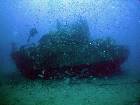 Curtin
Artificial Reef: The construction of Curtin Artificial Reef commenced in
1968 with the Underwater Research Group of Queensland sinking the first ship,
an old barge and some pontoons. The reef was named after the late URGQ member
Mr Frank Curtin who derived the artificial reef concept. The reef now consists
of more than 20 wrecks including countless tyres, cars and pipes and a vast
array of old harbour and marine navigation buoys. These wrecks and structures
have all been purchased, cleaned and scuttled by URGQ who have been working
on the project for almost 40 years. The diversity of fish life on the reef is
incredible. It attracts large pelagic species such as kingfish, mackerel and
cobia whilst providing shelter for a variety of tropical reef species including
snapper, lionfish, angelfishes and butterflyfishes. One of the best wrecks to
dive is the old tug 'the Melbourne' which sits in approximately 25 metres of
water. On a single dive on the Melbourne I recorded 34 different species of
fish and also encountered some humungous Queensland gropers that can only be
described as 'small underwater cars'!
Curtin
Artificial Reef: The construction of Curtin Artificial Reef commenced in
1968 with the Underwater Research Group of Queensland sinking the first ship,
an old barge and some pontoons. The reef was named after the late URGQ member
Mr Frank Curtin who derived the artificial reef concept. The reef now consists
of more than 20 wrecks including countless tyres, cars and pipes and a vast
array of old harbour and marine navigation buoys. These wrecks and structures
have all been purchased, cleaned and scuttled by URGQ who have been working
on the project for almost 40 years. The diversity of fish life on the reef is
incredible. It attracts large pelagic species such as kingfish, mackerel and
cobia whilst providing shelter for a variety of tropical reef species including
snapper, lionfish, angelfishes and butterflyfishes. One of the best wrecks to
dive is the old tug 'the Melbourne' which sits in approximately 25 metres of
water. On a single dive on the Melbourne I recorded 34 different species of
fish and also encountered some humungous Queensland gropers that can only be
described as 'small underwater cars'!
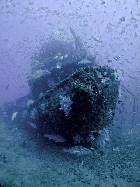 Cetacea:
The Cetacea is an old fishing trawler that sank in 1992 near the Capricorn-Bunker
Group of islands in the southern section of the Great Barrier Reef. This wreck
is absolutely teeming with fish and is one of the best fish wreck dives that
can be done with a maximum depth of 30 metres. This wreck is home to at least
40 estuary cod that can be found throughout the inside of the wreck and sitting
underneath the bow. Queensland Groper and giant Cobia can be seen on the sand
just off to the side of the wreck whilst large bull rays and leopard rays can
also be found resting on the sand. This wreck has a considerable amount of soft
coral growth that provide shelter for Anthias fish species and damsels. This
is probably my favourite wreck in south-east Queensland for diving.
Cetacea:
The Cetacea is an old fishing trawler that sank in 1992 near the Capricorn-Bunker
Group of islands in the southern section of the Great Barrier Reef. This wreck
is absolutely teeming with fish and is one of the best fish wreck dives that
can be done with a maximum depth of 30 metres. This wreck is home to at least
40 estuary cod that can be found throughout the inside of the wreck and sitting
underneath the bow. Queensland Groper and giant Cobia can be seen on the sand
just off to the side of the wreck whilst large bull rays and leopard rays can
also be found resting on the sand. This wreck has a considerable amount of soft
coral growth that provide shelter for Anthias fish species and damsels. This
is probably my favourite wreck in south-east Queensland for diving.
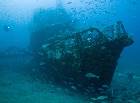 Barcoola:
The Barcoola is a legendary wreck for diving with some divers claiming it has
better marine life that the famous SS Yongala. When it comes to fish life the
Barcoola truly is a remarkable sight as it has created a huge artificial reef
in the middle of no mans land sitting on a sandy bottom. It is also in the vicinity
of the Bunker-Group. The Barcoola is an old steel fishing trawler that sank
about ten years ago and is quite deep for recreational diving at a depth of
44 metres. When you first descended on this wreck you will be astonished by
the fact that you can't see any metal; the massive school of baitfish hides
the wreck from sight! The wreck is home to many large estuary cod and Queensland
gropers with numerous reef species such as red emperors, tropical snappers and
coral trout hiding in amongst the structure. The other attraction to the Barcoola
is the pelagic fish species that can be found circling the wreck. The kingfish
are the size of sharks, the giant Cobia look like sharks and the Bronze Whalers
are, well the size of big Bronze whaler sharks! This is an outstanding wreck
dive and is considered the must do for wreck diving and fish enthusiasts.
Barcoola:
The Barcoola is a legendary wreck for diving with some divers claiming it has
better marine life that the famous SS Yongala. When it comes to fish life the
Barcoola truly is a remarkable sight as it has created a huge artificial reef
in the middle of no mans land sitting on a sandy bottom. It is also in the vicinity
of the Bunker-Group. The Barcoola is an old steel fishing trawler that sank
about ten years ago and is quite deep for recreational diving at a depth of
44 metres. When you first descended on this wreck you will be astonished by
the fact that you can't see any metal; the massive school of baitfish hides
the wreck from sight! The wreck is home to many large estuary cod and Queensland
gropers with numerous reef species such as red emperors, tropical snappers and
coral trout hiding in amongst the structure. The other attraction to the Barcoola
is the pelagic fish species that can be found circling the wreck. The kingfish
are the size of sharks, the giant Cobia look like sharks and the Bronze Whalers
are, well the size of big Bronze whaler sharks! This is an outstanding wreck
dive and is considered the must do for wreck diving and fish enthusiasts.
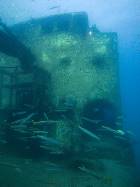 Karma:
The Karma is a large barge that sank off Agnes Waters in 2003. It originally
ran aground on a beach south of Agnes Waters and was high and dry for a few
weeks before being dragged off the beach by salvage operators. During the recovery
the Karma decided floating was no longer her thing and she became a new edition
to the ocean floor sitting upright in 27 metres of water. Within a year of sinking
huge amounts of fish life have been attracted to this wreck with giant estuary
cod taking up residence at the prop and in the large crane. Schools of Golden
and Big-eye trevally can be seen circling the wreck and large leopard rays can
be found in the sand. This is also one of the few wreck dives that allows for
excellent penetration as divers can explore the inside of the hold and wheelhouse.
The Karma has the potential to become one of the best fish magnets off the south
Queensland coast.
Karma:
The Karma is a large barge that sank off Agnes Waters in 2003. It originally
ran aground on a beach south of Agnes Waters and was high and dry for a few
weeks before being dragged off the beach by salvage operators. During the recovery
the Karma decided floating was no longer her thing and she became a new edition
to the ocean floor sitting upright in 27 metres of water. Within a year of sinking
huge amounts of fish life have been attracted to this wreck with giant estuary
cod taking up residence at the prop and in the large crane. Schools of Golden
and Big-eye trevally can be seen circling the wreck and large leopard rays can
be found in the sand. This is also one of the few wreck dives that allows for
excellent penetration as divers can explore the inside of the hold and wheelhouse.
The Karma has the potential to become one of the best fish magnets off the south
Queensland coast.
Some of the other
really good dives in the region include the wrecks of the Linda Jane, Bindaree,
Nautilus, Moreton Star, Shannon II and the Shoalhaven. All of these wrecks can
be accessed off the coastline between Bundaberg and Gladstone.
 The
most recent trip to some of these wrecks occurred in November 2005 and it was
the first time I really noticed the benefits of diving on a closed circuit rebreather
(CCR). Outside of the fact that diving on a Sports KISS allowed for longer bottom
times on the wrecks, the huge benefit was that with no noise and no bubbles
we could get so much closer to fish. Queensland groper and estuary cod are known
to swim away from divers, probably because of the noise generated by bubbles.
However on CCRs we found that the gropers and cod would actually swim up to
us to check us out. This was a huge change to the previous trips and allowed
us to interact much better with the marine life as well as being able to photograph
fish at a much closer distance.
The
most recent trip to some of these wrecks occurred in November 2005 and it was
the first time I really noticed the benefits of diving on a closed circuit rebreather
(CCR). Outside of the fact that diving on a Sports KISS allowed for longer bottom
times on the wrecks, the huge benefit was that with no noise and no bubbles
we could get so much closer to fish. Queensland groper and estuary cod are known
to swim away from divers, probably because of the noise generated by bubbles.
However on CCRs we found that the gropers and cod would actually swim up to
us to check us out. This was a huge change to the previous trips and allowed
us to interact much better with the marine life as well as being able to photograph
fish at a much closer distance.
And finally, with
the sinking of the HMAS Brisbane off Mooloolaba in Queensland there is another
new home for fish species to inhabitat. I wonder how long before this 'fish
magnet' becomes home to the estuary cod and Queensland Groper, only time will
tell.
HOME
 The
waters of south-east Queensland are the final resting place for many ships and
this part of the Australian coastline is a haven for divers interested in ship
wrecks. A diver can fly into Brisbane and within two hours they can be blowing
bubbles on the wreck of the Saint Paul or searching through the many ships and
structures of Curtain Artificial Reef. Some divers get a real thrill out of
diving on shipwrecks as it's something different to swimming around the standard
'fishbowl' coral reef or sponge gardens. Many of my diving colleagues love their
wrecks, actually I would have to say for some of them it's an obsession. Some
of them are more attracted to rust than their own partners, now go figure that
one out! Others get this glint in their eyes which can be instantly recognised
as 'Brass Fever'; I thinks that's pretty self explanatory!
The
waters of south-east Queensland are the final resting place for many ships and
this part of the Australian coastline is a haven for divers interested in ship
wrecks. A diver can fly into Brisbane and within two hours they can be blowing
bubbles on the wreck of the Saint Paul or searching through the many ships and
structures of Curtain Artificial Reef. Some divers get a real thrill out of
diving on shipwrecks as it's something different to swimming around the standard
'fishbowl' coral reef or sponge gardens. Many of my diving colleagues love their
wrecks, actually I would have to say for some of them it's an obsession. Some
of them are more attracted to rust than their own partners, now go figure that
one out! Others get this glint in their eyes which can be instantly recognised
as 'Brass Fever'; I thinks that's pretty self explanatory!






